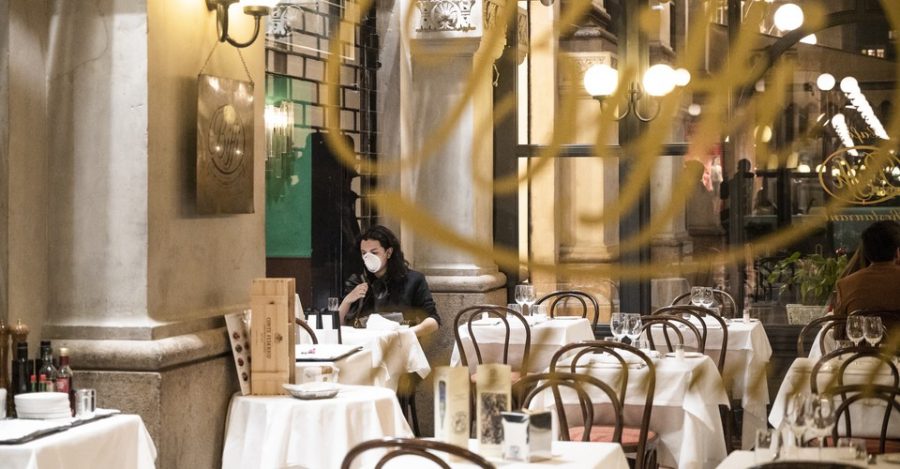Burton: Now’s the Time to Buy Directly From Utah Restaurants
Valeria Ferraro / Echoes WIre
A tourist wears a protective mask at Biffi Restaurant in Galleria Vittorio, Milan, amid coronavirus fears. (Photo by Valeria Ferraro | Courtesy Getty Images)
August 11, 2020
Burton: Buy Directly From Utah Restaurants
COVID-19 demonstrates the fragile foundations of both advanced and developing economies. With how interconnected the global economy is, an incident in one local area or market can quickly collapse the rest of the economy. During the 2008 financial crisis, for example, a subprime-lending practice in the United States started a domino effect that soon hit the world economy. Now, a virus from faraway China and the shutdowns resulting from it have brought down the world economy as well.
It has affected markets and workers of all sorts. Small businesses like local restaurants are no exception to the challenges brought on by adapting to changing to a slumping economy. Among these adaptations is the increased use of third party delivery-services like Uber, GrubHub and Doordash. However, the commissions of these companies strain profits. Recently, this quandary has been felt by several Utah restaurants. To help local restaurant owners and workers, Utahns should order directly.
Restaurants are No Cheap Business
Like any business, restaurants have high operating costs. Just in starting-up, a restaurant needs to spend on rent, kitchen, dining space and interior and administration. This could cost from $175,000 up to $750,000. Even after the start-up, restaurants have to not only continue paying rent and managing the restaurant, but also pay for labor, equipment, and advertising. This contributes to the small profit margins of restaurants. Many restaurants only earn mere cents to every dollar they spend. In other words, restaurants are under the constant threat of going under. Orders have to be constant.
For restaurants to increase their profit margins, costs have to be reduced. This could mean increasing sales, readjusting menu prices, using technology, or increasing worker efficiency (i.e. better hiring and training). In the case of using third party delivery apps, this adds even more strain to profit margins. These apps can take from 25% up to 35% in commission. Restaurants are losing significant revenue with each order. To keep our local businesses afloat, Utahns should order directly from restaurants and abandon third-party delivery apps which allows the flow of transactions, on which the restaurant survives, to keep going.
Questionable Practices
In theory, third-party delivery services act as a good way for small restaurants, unable to afford their own delivery service, to reach more customers. In a 2018 article from industry publication Restaurant Business, nearly half of all restaurant sales are off-premise. Of the 44% off-premise sales, 25% of them are for delivery. This indicates that there is a significant clientele base outside of the restaurant to target. However, despite the promise of reaching more customers, major third-party delivery services companies are under severe questioning for their less than transparent practices.
Grubhub, a major player in the delivery market, is subject to lawsuits and criticism from restaurants for their practices that stealthily siphons money from operating costs. On June 19, 2019, New York City held a public meeting where restaurant owners complained of the practices of the third-party delivery services. Not only should the government and restaurants hold these companies accountable, but customers as well. By going to the restaurant directly, it eliminates the questionable revenue given to the middle-man. On top of all that, the restaurant will now have more profits to help in making the restaurant better. Governments are intervening after numerous complaints, but in many cases, the buying habits of normal customers can create success or failure of a business better than the government.
The Dilemma of Delivery
COVID-19 may be remembered as a period of adaptation. Much like Darwin’s theory of evolution, firms need to adapt and innovate or be out of business. Restaurants, like many other industries, face this challenge as well. This challenge, however, isn’t in cooking or dining technology. Instead, it is a challenge in using technology to reach customers.
A considerable portion of customers is ordering food off of restaurant premises. Business consulting group Zion suggests in a study that 63% of younger adults use third party delivery apps. For a small restaurant, this is a significant group of people to reach. This places restaurants in a tough situation. Restaurants can have a predatory relationship with third-party apps but in order to succeed in the future must rely on some sort of delivery service. There is good news. Third-party delivery apps have to adapt too. If they continue on enacting their practices, another app could easily disrupt them with the promise of cheaper prices.
Restaurant ownership and management is a difficult business to run. Now, with social distancing measures limiting customer access for restaurants, the wounds of unfair relations with delivery apps are made worse. In the end, this relationship is not sustainable. Both restaurants and app developers have to change or be destroyed.








